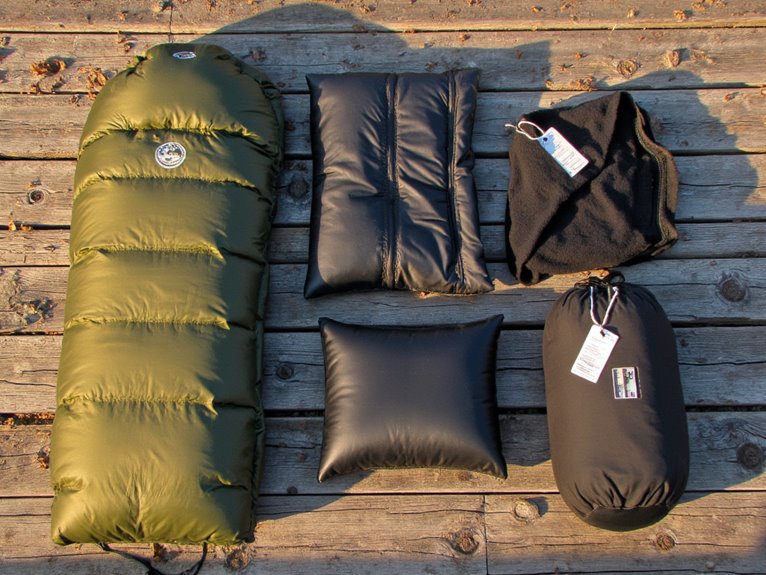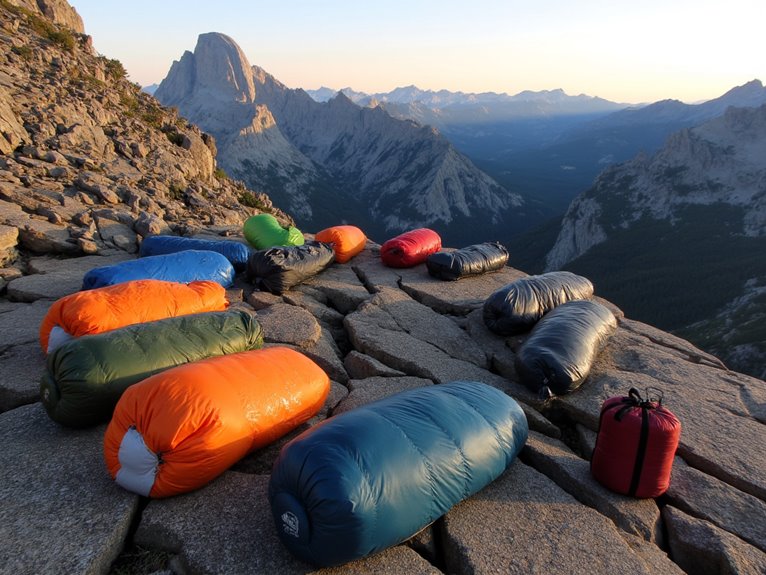Creating a Sleep System on a Budget (Under $300 or $500)
You can build a complete sleep system for under $300 by combining a basic tarp or budget tent ($15-$50), a 35-40°F rated sleeping bag ($60), and a foam sleeping pad ($20). For $500, you’ll upgrade to a double-walled tent, higher-quality sleeping bag with better temperature ratings ($150-$250), and comfortable inflatable pad ($50-$100). Both budgets require strategic gear selection focusing on essential functionality over premium features. The following builds demonstrate how to maximize warmth and comfort within these constraints.
We are supported by our audience. When you purchase through links on our site, we may earn an affiliate commission, at no extra cost for you. Learn more. Last update on 10th December 2025 / Images from Amazon Product Advertising API.
Notable Insights
- $300 Budget System: Include a budget tent/tarp ($15-$50), 35-40°F sleeping bag ($60), basic sleeping pad ($20), and entry-level backpack ($20-$160).
- $500 Budget System: Upgrade to mid-range double-walled tent, better sleeping bags ($150-$250), and comfortable inflatable pads ($50-$100) for extended trips.
- Tarp and bivy combinations provide complete weather protection under $200 while weighing less than three pounds total.
- Sleeping pad R-values indicate insulation effectiveness; choose 4-5 inch thickness for optimal comfort, especially for side sleepers.
- Temperature rating safety margin: Select sleeping bags rated 15°F below expected conditions to ensure adequate warmth throughout the night.
Understanding the Core Components of Your Sleep System
When building a sleep system on a budget, understanding the four core components will determine whether you wake up refreshed or spend the night shivering.
Your sleeping bag provides the primary insulation layer through synthetic fill or down materials. Temperature ratings indicate the lowest safe operating temperature—select bags rated 15°F below your expected conditions.
Sleeping pads prevent ground heat loss and offer comfort through foam or inflatable designs. R-values measure insulation effectiveness: aim for R ≥ 2.0 for three-season use, R ≥ 4.0 for winter conditions.
Camp pillows enhance comfort but aren’t essential—stuff sacks filled with clothes work as substitutes.
Finally, layering systems using base layers, liners, and blankets extend your sleeping bag insulation range while maintaining budget constraints.
For optimal portability during backpacking trips, choose sleeping bags weighing between 3-6 pounds with compression sacks for easy transport.
Shelter Options That Won’t Break the Bank
You don’t need to spend hundreds of dollars to get reliable shelter for your outdoor sleep system.
Quality budget tents under $300 offer solid protection, while ultralight tarp and bivy combinations can cut weight and cost considerably.
The used gear market presents excellent opportunities to acquire premium shelters at fraction of retail prices, though you’ll need to inspect seams and waterproof coatings carefully.
Budget Tent Recommendations
Although tent prices can climb into the thousands for premium models, proven shelter options exist at every budget level without sacrificing essential protection.
Affordable materials like polyester and aluminum poles deliver reliable performance while keeping costs down. Weight considerations become vital when choosing between car camping and backpacking designs.
Here are four tested budget recommendations:
- Gossamer Gear The One – 17.7 oz ultralight at $255 for solo backpacking
- Coleman Sundome 4 – $100 car camping tent with reliable weather protection
- REI Co-op Trail Hut 2 – $229 backpacking option balancing weight and durability
- Core Equipment Instant Cabin 6 – Quick-setup family tent under $150
These models prioritize essential features like waterproof rainflies and sturdy construction over premium lightweight materials, delivering dependable shelter without premium pricing.
Tarp and Bivy Setup
Two basic pieces of gear can deliver complete weather protection for under $200: a quality tarp and bivy sack combination.
You’ll need a silnylon tarp like the ANDA Uno Mas, plus a bivy such as the ANDA Burrito Bivy. Your existing trekking poles become structural support, eliminating tent pole costs.
Master essential tarp configurations: A-frame setups use corner stakes and ridge pole tension, while Plough Point shelters require minimal anchoring for rapid deployment.
Continuous ridge line methods work between trees using prussik knots for adjustment.
Bivy maintenance involves regular seam sealing and zipper lubrication to prevent moisture intrusion. Choose appropriate stakes for your terrain—soft ground needs longer stakes, rocky areas require specialized anchors.
This system weighs under three pounds while providing complete weather protection at half the cost of comparable tents.
Used Gear Opportunities
When manufacturers release new tent models each season, last year’s designs flood the used gear market at dramatically reduced prices.
You’ll find respected backpacking tents that originally retailed for $400 selling for $150-250.
Used gear benefits include immediate availability and proven durability – these tents have survived real-world testing.
Follow these online marketplace tips for smart purchases:
- Inspect waterproof coatings for delamination or flaking
- Check zippers for smooth operation and intact teeth
- Verify pole integrity with no cracks or bent sections
- Examine seam tape for proper adhesion
Platforms like Geartrade offer 80% discounts with quality guarantees.
Local classifieds and outdoor forums provide additional options.
Focus on materials like ripstop nylon with PU coatings exceeding 3000mm hydrostatic head ratings.
Choosing the Right Sleeping Pad for Comfort and Warmth
Three distinct types of sleeping pads dominate today’s market, each engineered for specific camping scenarios and budget constraints.
Air pad advantages include exceptional compactness and superior R-values like the Therm-a-Rest XTherm NXT’s 7.3 rating.
Air pads deliver unmatched packability and thermal efficiency, with premium models achieving R-values exceeding 7 for extreme conditions.
Self inflating comfort combines open-cell foam with convenience, delivering memory foam-like feel for car camping.
Foam pad durability makes closed-cell options virtually indestructible—perfect for thru-hiking where puncture risks can’t be tolerated.
R value importance can’t be overstated when selecting warmth capabilities. Higher ratings provide better insulation but increase costs considerably.
Budget friendly options start with closed-cell foam pads, offering reliable performance without premium pricing.
Weight considerations matter most for backpacking, where ultralight air pads excel despite higher costs.
Balance your camping style against budget constraints—car campers benefit from thicker self-inflating models while backpackers prioritize lightweight air pad efficiency.
For optimal comfort and support, look for sleeping pads with 4-5 inches of thickness, as this provides the best balance of cushioning and pressure relief for most sleeping positions.
Budget-Friendly Sleeping Bags and Quilts That Deliver
Quality sleep systems don’t require premium prices when you understand which features matter most for your camping style.
Budget sleeping bag features like adjustable hoods, shoulder baffles, and insulated zippers effectively minimize heat loss in sub-$200 options. The Alpkit Pipedream 200 delivers 750 fill power DownTek at $200, weighing just 545 grams.
Synthetic alternatives like the Sierra Designs Night Cap 20 provide reliable 20°F protection for $140.
Key sleeping bag features to prioritize:
- Insulation type – Down for weight savings, synthetic for moisture resistance
- Temperature rating – Match your typical camping conditions precisely
- Weight and packability – Quilt insulation often outperforms bags here
- Water resistance – Treated down and shell fabrics improve performance
REI Magma 30 Trail Quilt exemplifies superior quilt insulation efficiency at $329.
Budget-conscious campers should note that compression sacks are vital for easy transport and backpacking, though larger bags may have cumbersome storage sizes when building a complete sleep system under budget constraints.
Essential Accessories to Complete Your Setup

Your sleeping bag choice sets the foundation, but strategic accessories can maximize warmth and comfort without breaking your budget.
Pillow alternatives offer the most cost-effective upgrade. Skip dedicated pillows and stuff your puffy jacket or fleece into a compression sack for zero additional weight. Alternatively, lightweight compressible pillows cost $15–$30.
Insulation options provide essential warmth enhancement. Sleeping bag liners add 5–15°F for $20–$50 while keeping your bag clean. Mylar emergency blankets deliver extra insulation under $10.
Wool socks, glove liners, and beanies worn to bed retain heat efficiently. Down booties ($30–$60) maximize foot warmth.
Organization accessories complete your system. Compression sacks reduce bulk for $10–$25. Waterproof stuff sacks protect gear in wet conditions for $10–$20.
Budget sleeping pads with built-in pumps eliminate the need for external inflation equipment while providing essential ground insulation for under $50.
Sample Sleep System Builds for $300 and $500 Budgets
Two distinct budget tiers allow you to build complete sleep systems that balance performance with cost constraints.
Your $300 build prioritizes essential functionality, while the $500 tier delivers enhanced durability and comfort for extended backcountry use.
$300 Budget Sleep System Components:
- Shelter: Budget tent or tarp ($15-$50) provides basic weather protection.
- Insulation: 35-40°F rated sleeping bag ($60) handles moderate temperatures.
- Ground Protection: Basic sleeping pad ($20) offers vital ground insulation.
- Transport: Entry-level backpack ($20-$160) carries your complete setup.
The $500 build upgrades each component considerably.
You’ll access mid-range double-walled tents, sleeping bags with improved temperature ratings ($150-$250), and more comfortable inflatable pads ($50-$100).
Side sleepers should prioritize pads with 3 to 5 inches of thickness to prevent hip and shoulder pressure points that can disrupt sleep quality.
Gear compatibility becomes vital at this level, ensuring your sleep system components work seamlessly together for maximum performance.



